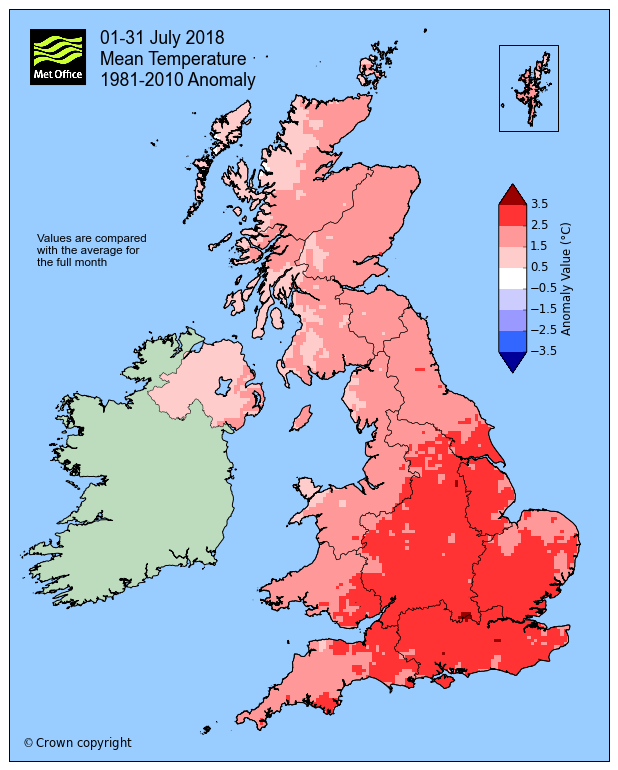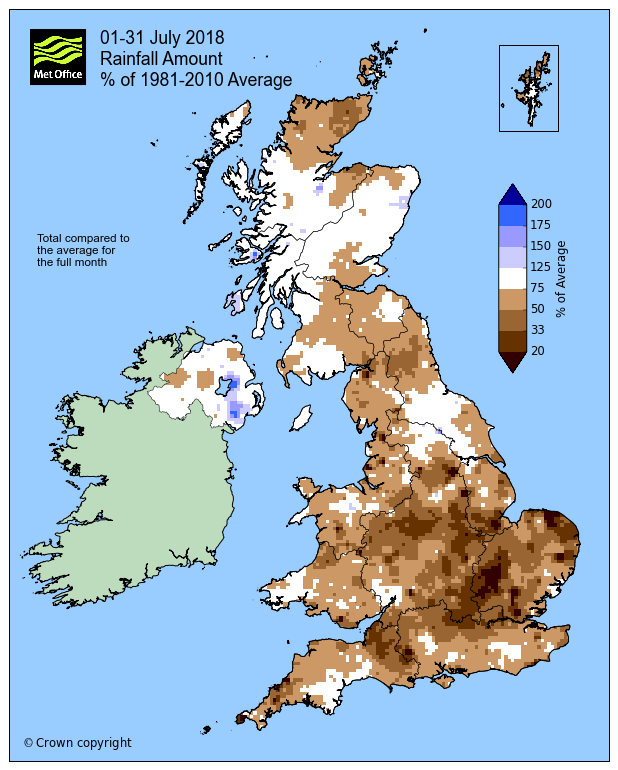Early end of July statistics
Author: Press Office
15:14 (UTC+1) on Tue 31 Jul 2018
Although the story of the weather this month has been the prolonged high temperatures, particularly in the South East of England, in fact for the UK as a whole, provisional temperature data tell us this July is only the third warm
The provisional statistics show that July 2018, with a mean average temperature of 17.2 °C, is behind the 2006 record of 17.8 degrees, and also the 17.3 degrees mean in 1983.
July 2006 stands as the warmest on record (records dating back to 1910), with an average UK daily maximum of 23.2 °C. At 22.5 degrees for the month, this July’s average daily maximum temperature was brought down by the change in the weather near the end of the month, as rain and high winds quenched the heatwave.
In terms of monthly maximum average temperatures, then 2018 ranks second, at 22.5 degrees, behind 2006 which was 23.2 °C, and ahead of 22.2 °C in 1983.
On 26 July, Faversham in Kent saw temperatures reach 35.3 °C – this was the UK’s highest July temperature since 1 July 2015, when Heathrow saw a peak of 36.7 Celsius. While that remains the all-time record for July, the highest maximum temperature ever recorded in the UK was 38.5°C, at Faversham on 10 August 2003.

Using the average daily maximum temperature it is the second hottest July on record for England, with only 2006’s average daily maximum temperature of 25.2°C being higher than the current provisional figure of 24.8°C. Wales’s figure stands at 22.6 °C - the third hottest, behind hottest-ranked 1983 at 23.1°C.
With an average maximum daily temperature of 19.2 °C, July 2018 is ranked fourth hottest in Scotland – the hottest was July 2006 at 20.3°C . For Northern Ireland, 20.2 °C makes it provisionally the eighth hottest July on record, with the all-time record average daily max of 21.8 °C reached in 2013.
However, it has been a record breaking month for the south east of England with the average daily maximum temperature reaching 26.2 °C, the highest July for the region – just exceeding 2006’s previous record of 26.1 degrees.
| Maximum temp | Mean temps | Rainfall | Sunshine | |||||
|---|---|---|---|---|---|---|---|---|
| Area | Actual C | Anom | Act C | Anom | Actual mm | Anom % | Actual hours | Anom % |
| UK | 22.5 C | 3.2 C | 17.2 C | 2.1 C | 55.6mm | 71 | 239.7 | 139 |
| England | 24.8 C | 3.8 C | 18.8 C | 2.5 C | 34.4mm | 55 | 276.6 | 143 |
| Wales | 22.6 C | 3.4 C | 17.3 C | 2.1 C | 60.7mm | 66 | 252.5 | 141 |
| Scotland | 19.2 C | 2.2 C | 14.9 C | 1.6 C | 84.8mm | 85 | 186.2 | 132 |
| N Ireland | 20.2 C | 1.7 C | 15.8 C | 1.2 C | 80.6mm | 99 | 178.1 | 127 |
Although July was largely a dry month, it was only the sixteenth driest on record for the UK since records began in 1910, with England being the driest country receiving just over half its average rainfall for the month. However, other UK nations were much closer to normal. The late torrential rain in Northern Ireland, particularly, brought its provisional rainfall total to 99% of the average.
The dry spell was most prolonged in East Anglia and south-east England, where some places such as Heathrow and High Wycombe experienced 58 ‘dry days’ in a row (a ‘dry day’ is defined as a day with less than 1.0 mm of rain recorded). Broom’s Barn, near Bury St Edmunds, experienced 51 days of no rain at all – the longest this summer. However, the storms at the end of the month pushed the level of actual rainfall received in the whole region to 21.0mm – only the eighth driest on record.

Dr Mark McCarthy, Manager of the Met Office National Climate Information Centre, said: “The UK experienced its hottest ever May this year, and its second hottest June. For a large part of July it looked as if we might see another record-breaking month, but lower temperatures in the North and West and the storms at the end of the month meant that was not the case.
“However, temperatures were well above average and rainfall much lower, particularly in parts of England, continuing the pattern of an unusually warm, dry summer overall.”
You can find the current forecast for your area using our forecast pages, by following us on Twitter and Facebook, or using our mobile app which is available for iPhone from the App store and for Android from the Google Play store.


